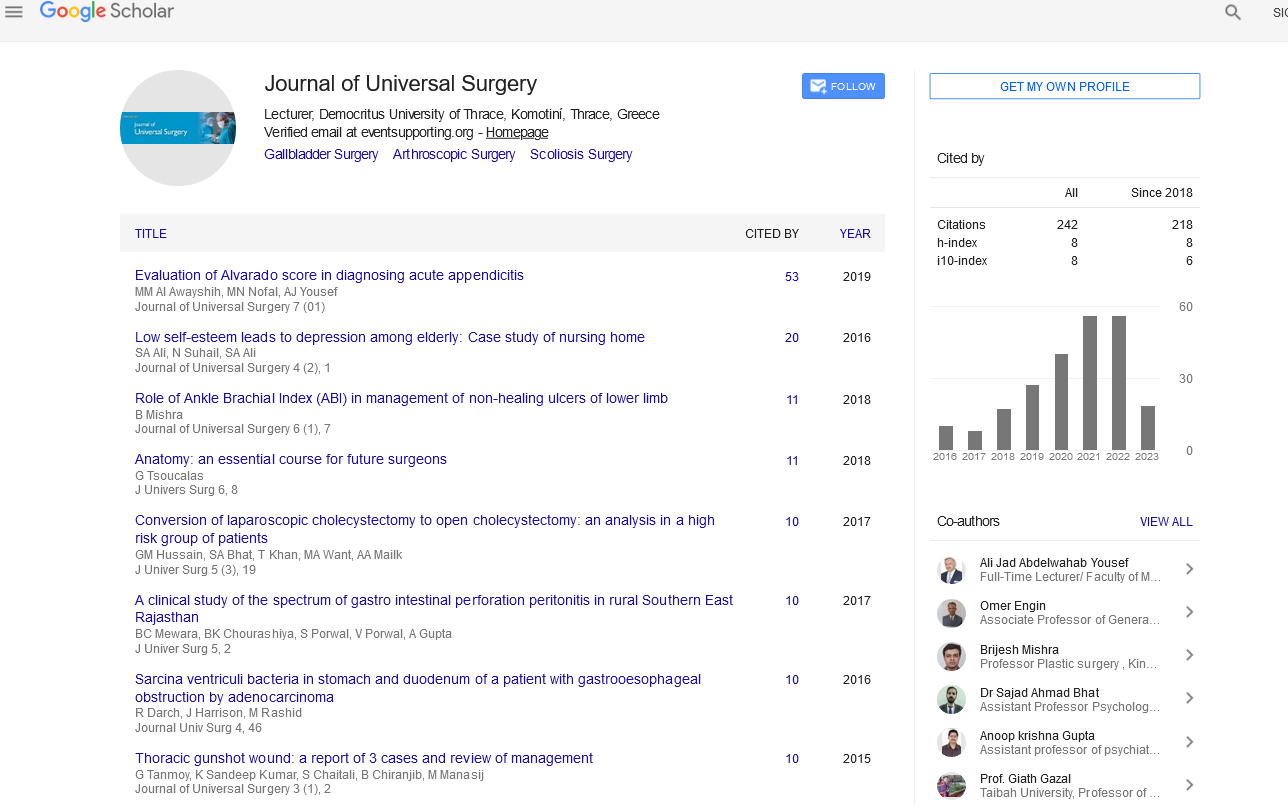Perspective - (2023) Volume 11, Issue 5
Pacemaker surgery: A lifesaving intervention
Iqbal Afusar*
Department of Cardiology, University of Avanos, Avanos, Turkey
*Correspondence:
Iqbal Afusar, Department of Cardiology, University of Avanos, Avanos,
Turkey,
Email:
Received: 04-Sep-2023, Manuscript No. ipjus-23-14283;
Editor assigned: 09-Nov-2023, Pre QC No. P-14283;
Reviewed: 21-Sep-2023, QC No. Q-14283;
Revised: 03-Oct-2023, Manuscript No. R-14283;
Published:
19-Oct-2023
Introduction
Hydro pacemaker surgery, a critical medical procedure, is a
lifesaving intervention that has transformed the lives of
countless individuals suffering from heart rhythm
abnormalities. With approximately, we'll delve into the
significance of pacemakers, the surgical process, and the
impact on patients' lives.
Description
A pacemaker is a small, implantable device designed
to regulate and maintain a regular heart rate, ensuring that
the heart beats at the right rhythm. his innovative
technology has been a game-changer for those with
heart rhythm disorders, allowing them to lead healthier,
more fulfilling lives. In this comprehensive overview, we
will explore the intricate world of pacemaker surgery,
from its necessity to the surgical procedure and its
transformative effects on patients.
The necessity of pacemaker surgery
A malfunctioning heart rhythm can have severe
consequences, ranging from fainting spells and fatigue to
life-threatening conditions such as heart failure and sudden
cardiac arrest. Pacemaker surgery becomes a necessity
when the heart's natural electrical system fails to function
properly, causing irregular heartbeats. he common
conditions that warrant a pacemaker implant include atrial
fibrillation, bradycardia (slow heart rate), heart block, and
other arrhythmias. The symptoms of these conditions can
be debilitating, often interfering with daily activities and
reducing one's quality of life.
Understanding pacemakers
Pacemakers are remarkable devices, about the size of a
silver dollar, that are implanted just under the skin of the
chest. They consist of several key components, including a
pulse generator, leads (wires), and sensors. The pulse
generator is the pacemaker's "brain," producing electrical
impulses to stimulate the heart muscle. Leads are thin,
insulated wires that carry these electrical signals from the
pulse generator to the heart muscle. he sensors
continuously monitor the heart's activity, ensuring that
the device responds to the body's needs.
The surgical procedure
Pacemaker surgery is typically performed in a
specialized healthcare facility, such as a cardiac
electrophysiology lab or an operating room. The
procedure is done under local anesthesia, and patients
often remain awake. Here is an overview of the surgical
process:
Preparation: The patient's chest area is cleaned and
sterilized to prevent infection. An Intravenous (IV) line is
inserted to administer fluids and medications throughout
the procedure.
Local anesthesia: A local anesthetic is injected to numb
the area where the pacemaker will be implanted. This
ensures that the patient does not feel any pain during the
surgery.
Incision: The surgeon makes a small incision (usually
around 2-3 inches) just below the collarbone.
Lead placement: The leads are carefully threaded through a
vein, guided to the heart's chambers, and connected to
the pulse generator.
Pulse generator placement: The pulse generator is
inserted under the skin, usually just below the collarbone,
and connected to the leads.
Testing: The pacemaker is tested to ensure that it
functions correctly, adjusting its settings as needed to
meet the pa Closure: Once the pacemaker is properly
implanted and tested, the incision is closed with sutures
or staples patient's specific requirements.
Recovery: Patients are monitored for a brief period
to ensure there are no immediate complications. They
may be discharged the same day or kept overnight for
observation.
Life after pacemaker surgery
Pacemaker surgery can be a life-altering experience
for individuals who undergo it. The device helps regulate
their heart rhythm, alleviating symptoms and improving
their overall quality of life. However, patients must adapt
to a few changes in their daily routines:
Regular follow-up: Patients need to attend regular
check-ups with their cardiologist or electrophysiologist to
ensure the pacemaker continues to function correctly.
Activity levels: While most activities can be resumed,
patients may need to avoid intense contact sports or
activities that involve strong magnetic fields that can
interfere with the device.
Battery replacement: Pacemakers have a limited battery
life, usually between 5 to 15 years. When the battery nears
its end, a simple procedure is performed to replace the
generator while keeping the existing leads in place.
Emotional adjustment: Coping with the knowledge
of an implanted device can be emotionally challenging,
but support from healthcare providers and loved ones is
crucial.
Conclusion
Pacemaker surgery is a remarkable medical procedure that
has provided new hope and improved quality of life for
millions of people suffering from heart rhythm disorders.
These small devices, implanted through a relatively
straightforward surgical procedure, can make an enormous
difference in the lives of patients. With regular follow-up
and the right adjustments, pacemaker recipients can enjoy a
life free from the constraints of their previous heart
conditions. Pacemakers are not just lifesavers; they are
instruments of transformation, allowing individuals to
embrace a healthier and more active future.





